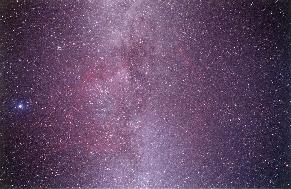Truth in Advertizing | 
|
|---|
The e-mails about spectroscopy I've been sending you have been a bit simplistic. This made it easier to get to where we could talk about wobbling stars but now that we understand all that, lets go back and clear up a few things.
We talked about the dark line spectra of stars. Well, stars only "kinda" have bright line or dark line spectra.
Stars are almost entirely Hydrogen and Helium. Most stars do have very small amounts of other element that they got from other stars that blew up years ago (same place the atoms in your body came from). It shouldn't come as any surprise that stars are hot. The surface you can see (the photosphere) and the interior of stars are full of atoms (mostly Hydrogen and Helium remember) that are squeezed together by gravity. Atoms squeezed together rub against each other so hard that the electrons, that normally orbit around the atom, get rubbed right off. Star-stuff is mostly a soup of naked nuclei (protons and neutron from the center of atoms), and free roaming electrons. These free roaming electrons "talk" to each other, using photons, when they bang into each other.
Remember way back at the start of this lesson when we burned alcohol on salt and we discussed how the electrons talked to each other? Well the electrons in stars don't say, "Hi! I'm an electron in the outermost shell orbiting a sodium atom." Oh no. The electrons in stars say things like, " Hey, it's really HOT here! Ouch! Watch were you're going! Hey it's really, really HOT here!" Since these electron are free roaming, they don't emit specific "colors" of light. These electrons emit photons of all colors depending on hot fast they were moving when they crash into another electron. This mixture of all colors is called a continuous spectrum and it is identical to the "rainbow" you get from the light of an incandescent light bulb passed through a prism.
Are you confused? First I tell you about the dark line spectrum of stars and now I tell you they don't have one! Dark absorption lines only happen when electron actually orbit an atom. Most atoms on the surface of a star don't have electrons "attached" but some few do for a few second. These can show dark absorption lines.
What happens if you go outside and shoot a gun straight up? The bullet heads up, up, up, loosing energy, going slower and slower, until it stops and gravity pulls it back to Earth. Well, this happen on stars too! No, no! People aren't shooting guns on stars! Some of those HOT electrons and nuclei are moving so fast that they go shooting up from the surface of the star where they loose energy and eventually fall back to the star. While they are up there, though, they are a cool gas and nuclei and electrons can join together. Guess what? Dark Lines!
One last "truth in advertising". All electrons in orbit in atoms can absorb and emit light (photons) of the same color. Imagine a cloud Hydrogen. Whether you see a bright line or a dark line in its spectra depends entirely on what is behind the cloud. The Hydrogen atoms in the cloud are absorbing photons and re-emitting them. If there is nothing in our line of sight behind the cloud except black empty space, all we see are the photons the clouds emit. If there is a star right behind the cloud (the cloud could be some of those "bullets" from the star), we see the continuous spectra of the star and the photons emitted from the cloud in front but the cloud also absorbed some photons. The colors that were absorbed we see as dark lines in the spectra. In other words, the dark lines are not black lines. They are just darker that the bright surface of the star. Got it?